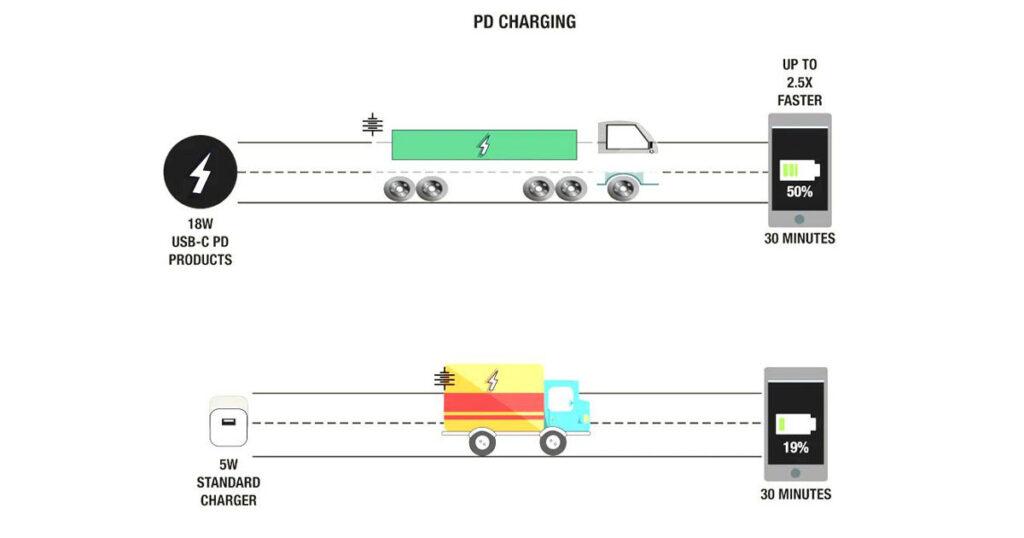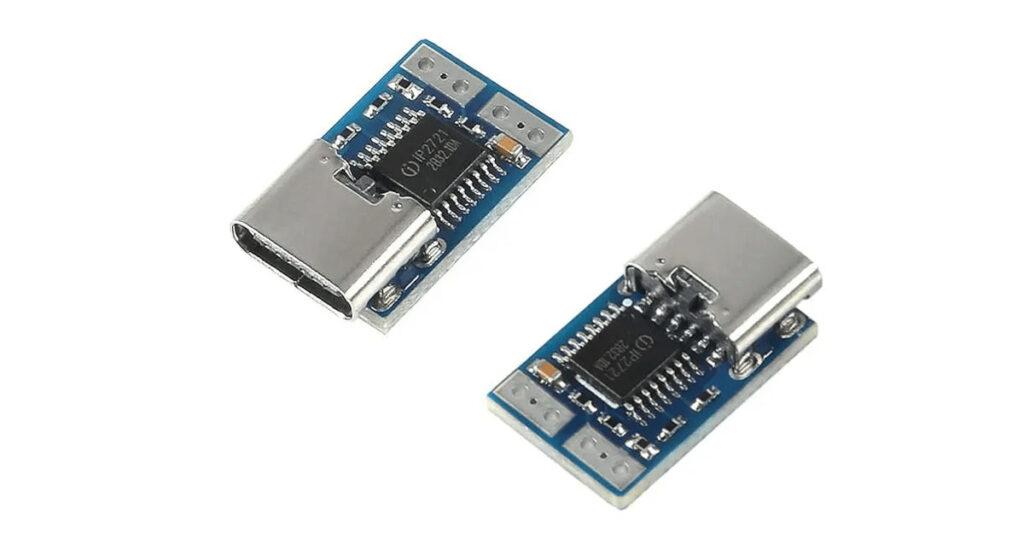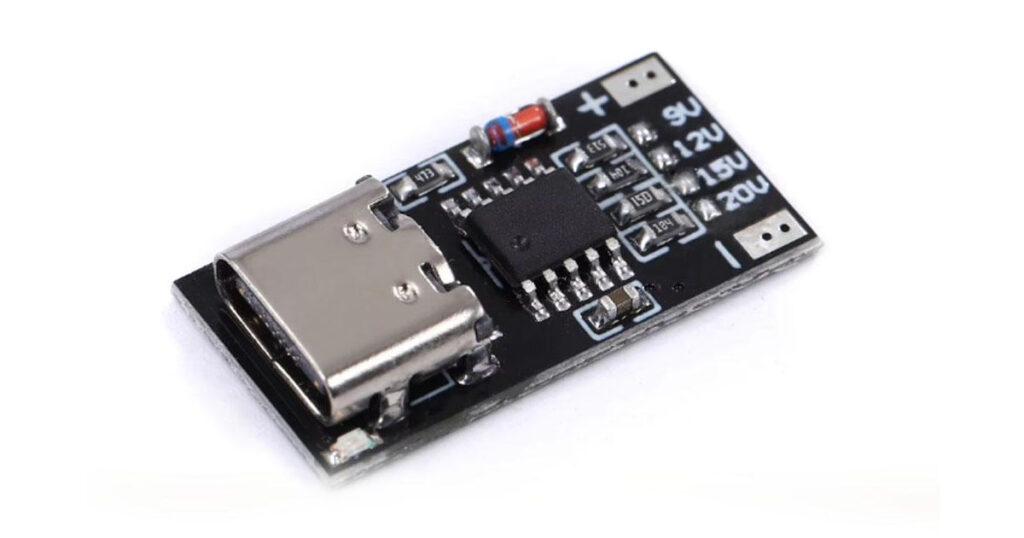PD VS. QC: the Differences between Fast Charging Technologies

In the age of smartphones, tablets, laptops, and other portable devices, the demand for faster charging is at an all-time high. Two of the most prominent fast-charging technologies leading the charge (pun intended) are Power Delivery (PD) and Quick Charge (QC). While both aim to significantly reduce charging time, they function quite differently and cater to varying needs. Here’s a breakdown of the differences between PD and QC to help you understand which might be the better fit for your devices.
What is PD (Power Delivery)?
USB Power Delivery (USB PD) is a universal fast-charging protocol that works through USB-C connectors. Developed by the USB-IF (USB Implementers Forum), PD is designed to be versatile, offering higher power levels, flexible voltage, and compatibility across various devices, not just smartphones. USB PD can deliver up to 100W of power, making it suitable for charging more power-hungry devices like laptops, gaming consoles, and monitors.
Versions Of PD Charging
Since its inception, the USB PD technology has come a long way, with multiple versions available.
USB PD 1.0
USB PD 1.0 is the most basic version of the modern USB, launched in 2012. It allowed power delivery of up to 100W over a single USB cable. It has a USB connector shape with minor differences in the internal wiring.
| USB PD 1.0 | ||||
| Profile | Voltage | Current | Power | Supported appliances |
| 1 | 5V | 2A | 10W | Smartphones, hard drives, and small accessories. |
| 2 | 12V | 1.5A | 18W | Smartphones, tablets, and large accessories. |
| 3 | 12V | 3A | 36W | Notebooks, displays, hubs, and future smartphones. |
| 4 | 20V | 3A | 60W | Larger notebooks, docking stations, and hubs. |
| 5 | 20V | 3A | 100W | Hubs, workstations, and external graphic cards. |
USB PD 2.0
In 2014, the USB PD 2.0 was launched, which favored more flexible power rules. It required the use of USB Type-C connectors and multiple normative voltages and currents. Hence, USB PD 2.0 offered smooth power usage and delivery among devices.
USB PD 3.0
Now let us understand what is PD 3.0 charging and why it is preferred. Released in 2015, USB PD 3.0 allowed the advanced use of Type C power functionalities and capabilities. An essential feature of USB PD 3.0 is role swapping.
If you are charging your laptop using an external battery, a USB Type-C charger can allow the devices to swap roles as long as power conditions are met. That means your computer can become the power provider rather than the consumer without you having to rotate the cables.
| USB PD 2.0/3.0 | ||||
| Profile | Voltage | Current | Power | Supported appliances |
| 1 | 5V | 0.1 – 3.0A | 10W | Headphones and small accessories. |
| 2 | 9V | 1.67 – 3.0A | 15 – 27W | Smartphones, cameras, and drones. |
| 3 | 15V | 1.8 – 3.0A | 27 – 45W | Tablets and small laptops. |
| 4 | 20V | 3.0 – 5.0A | 45 – 100W | Displays and large laptops. |
Below is a quick overview of the power requirements of different appliances.

Key Features of Power Delivery:
- Wider Device Compatibility: USB PD supports a wide range of devices, including smartphones, tablets, laptops, and accessories. It is not brand-specific, allowing for cross-device charging with a single charger.
- Flexible Power Output: PD offers variable power output, typically at 5V, 9V, 15V, or 20V, allowing it to adjust the power based on the device’s needs. This prevents overheating or overcharging.
- Higher Power Delivery: USB PD can deliver up to 100W of power, making it ideal for more power-hungry devices like laptops, tablets, and even certain monitors. Most smartphones will utilize a lower wattage but still benefit from faster charging compared to traditional chargers.
- Two-Way Power: With PD, devices can both receive and send power, which enables features like reverse charging, where one device charges another.
- Industry Adoption: USB PD is becoming increasingly popular in the tech industry due to its universality and compatibility with USB-C ports, which are fast becoming the standard for charging ports across various devices.
What is QC (Quick Charge)?
Quick Charge (QC) is a proprietary fast-charging technology developed by Qualcomm. As the name suggests, QC is specifically designed for Qualcomm-powered devices, particularly those using Snapdragon processors. While it is also capable of delivering rapid power to compatible devices, QC’s appeal lies in its ability to charge devices at high speeds without needing specialized or expensive chargers.

Quick Charge 1.0 (2013)
- Release Year: 2013
- Power Output: 10W (5V/2A)
- Overview:
- Quick Charge 1.0 was the first iteration of Qualcomm’s proprietary fast-charging technology. It provided charging speeds up to 40% faster than standard USB charging (5V/1A at the time).
- This version was introduced with the Snapdragon 600 series of processors.
Quick Charge 2.0 (2014)
- Release Year: 2014
- Power Output: Up to 18W (5V/2A, 9V/2A, 12V/1.67A)
- Overview:
- Quick Charge 2.0 offered faster charging rates by supporting multiple voltage levels: 5V, 9V, and 12V.
- Devices could receive up to 75% faster charging compared to standard 5V/1A chargers.
- Introduced with Snapdragon 800 series and became widely adopted in many Android smartphones.
- QC 2.0 also supported more device types, including tablets and certain accessories.
Quick Charge 3.0 (2015)
- Release Year: 2015
- Power Output: 18W (Supports 3.6V to 20V in 200mV increments)
- Overview:
- QC 3.0 introduced Intelligent Negotiation for Optimum Voltage (INOV), allowing the device to request the exact voltage it needs. This increased charging efficiency and reduced heat.
- It supported charging speeds 38% more efficient than QC 2.0.
- With dynamic voltage scaling between 3.6V and 20V, QC 3.0 optimized power delivery for each charging scenario, offering flexibility and better heat management.
- This version was compatible with Snapdragon 430, 617, 618, 620, and 820 chipsets.
Quick Charge 4.0 (2017)
- Release Year: 2017
- Power Output: Up to 28W (5V/4.7A to 5.6A, or 9V/3A)
- Overview:
- QC 4.0 supported USB Power Delivery (USB PD) and the USB-C connector, making it more versatile and future-proof.
- Qualcomm claimed that QC 4.0 could provide 5 hours of battery life with just 5 minutes of charging.
- With Dual Charge (using two charging ICs), this version improved charging efficiency and heat dissipation.
- Introduced Battery Saver Technologies to improve battery longevity by reducing damage from high-speed charging.
Quick Charge 4+ (2018)
- Release Year: 2018
- Power Output: Up to 28W (Similar to QC 4.0, with extra features)
- Overview:
- Quick Charge 4+ introduced further optimizations over QC 4.0, including:
- Dual Charge+: Enhanced dual charging ICs for even better heat dissipation.
- Intelligent Thermal Balancing: Prevents overheating by directing current through the coolest path.
- Advanced Safety Features: Protection against overcharging, overheating, and short-circuiting.
- QC 4+ became the standard for premium devices using Snapdragon 845 and beyond.
- Quick Charge 4+ introduced further optimizations over QC 4.0, including:
Quick Charge 5.0 (2020)
- Release Year: 2020
- Power Output: Up to 100W+
- Overview:
- QC 5.0 was a major leap, offering 100W+ charging capability, ideal for larger devices like laptops as well as high-end smartphones.
- Qualcomm claims QC 5.0 can charge a phone from 0 to 50% in just 5 minutes.
- Built on USB Power Delivery (USB PD) and USB-C, QC 5.0 is also backward-compatible with earlier Quick Charge versions.
- Enhanced safety features include 12 separate voltage, current, and temperature protections, ensuring the battery remains cool and healthy during ultra-fast charging.
- Support for Dual and Triple Charge technologies enables multi-cell battery configurations for more efficient charging.
- Optimized for devices powered by Snapdragon 865 and higher.
Key Evolution Highlights:
- Increased Power Output: Starting from 10W (QC 1.0) to over 100W (QC 5.0).
- Better Thermal Management: As charging speeds increased, Qualcomm also improved heat dissipation and safety features.
- Device and Accessory Support: Initially focused on smartphones, later versions supported laptops, accessories, and a variety of consumer electronics.
- USB-C Integration: From QC 4.0 onward, Quick Charge embraced USB-C and USB Power Delivery, ensuring future-proof compatibility.
Key Features of Quick Charge:
- Speed-Centric Charging: Quick Charge focuses heavily on speed, with the latest iteration, QC 5.0, offering up to 100W of power, just like USB PD. Earlier versions like QC 4.0+ support up to 45W, while QC 3.0 typically delivers around 18W.
- Voltage Flexibility: QC optimizes power delivery by varying voltage levels in smaller increments, allowing for more efficient and cooler charging compared to traditional chargers. For instance, QC 3.0 adjusts voltage between 3.2V to 20V in 200mV steps, while QC 4.0 and 5.0 improve on this further.
- Backwards Compatibility: One of the strengths of Quick Charge is its backward compatibility. Even if your phone or charger uses an older QC version, they will still work together at the best possible speed.
- Device-Specific: Unlike PD, Quick Charge is more brand and device-specific, primarily limited to smartphones and tablets that feature Qualcomm processors. It doesn’t work universally across all devices.
- Heat Management: QC technology uses advanced algorithms to control power delivery, which reduces the risk of overheating and ensures efficient charging. QC 5.0 introduces improved thermal management, allowing for safer high-speed charging.
Comparing PD vs. QC:
| Feature | Power Delivery (PD) | Quick Charge (QC) |
|---|---|---|
| Power Output | Up to 100W | QC 5.0 offers up to 100W |
| Device Compatibility | Universal with USB-C devices | Limited to Qualcomm Snapdragon devices |
| Voltage Flexibility | Adjustable from 5V to 20V | QC 3.0: Adjusts from 3.2V to 20V |
| Backward Compatibility | No backward compatibility | Backward compatible with older QC |
| Two-Way Charging | Supports two-way (reverse) charging | Typically one-way charging |
| Thermal Management | Standard protection from overheating | Advanced heat management in QC 5.0 |
| Use Cases | Ideal for a wide variety of devices | Focused on Qualcomm-powered devices |
Which is Better for You?
1. Compatibility:
- PD (Power Delivery):
- Developed by the USB-IF (USB Implementers Forum), PD is a universal charging standard compatible with a wide range of devices, including smartphones, tablets, laptops, and gaming consoles.
- It works over USB-C connections and is widely supported by many brands like Apple, Samsung, and Google.
- QC (Quick Charge):
- Developed by Qualcomm, QC is primarily used with devices that have Qualcomm Snapdragon processors.
- While it supports USB-A and USB-C connections, its ecosystem is more limited to Android devices compared to PD.
Which is better?
- PD is more versatile and compatible with a broader range of devices.
2. Charging Speed:
- PD (Power Delivery):
- PD supports power output up to 100W, which makes it suitable for larger devices like laptops and even some monitors, in addition to phones.
- It adjusts power dynamically, ensuring optimal charging speeds for different devices.
- QC (Quick Charge):
- QC 5.0 can deliver power up to 100W, but earlier versions (e.g., QC 3.0 and 4.0) are more common, typically delivering 18W-27W.
- QC charges devices rapidly, especially in the first 50% of battery capacity.
Which is better?
- PD is better if you need to charge a variety of devices, including high-power electronics like laptops. QC is faster for quick top-ups, particularly in smartphones.
3. Efficiency and Heat Management:
- PD (Power Delivery):
- PD is designed to manage power efficiently, reducing heat generation during charging.
- It adjusts the power to the device’s needs, minimizing overheating.
- QC (Quick Charge):
- Newer versions of QC (4.0, 5.0) incorporate better heat management, but historically QC could cause phones to get hotter compared to PD.
Which is better?
- PD generally offers better efficiency and heat management, especially when charging for longer durations or high-powered devices.
4. Device Ecosystem and Usage:
- PD (Power Delivery):
- Ideal for users with multiple devices across different brands, especially those using USB-C. You can charge a MacBook, Android phone, or iPad with the same charger.
- QC (Quick Charge):
- Best for users with Qualcomm-powered Android phones, especially if they need rapid smartphone charging.
Which is better?
- If you have a mix of devices from different brands, PD is better. If you use primarily Qualcomm-powered Android phones, QC can be advantageous.
Conclusion:
- PD (Power Delivery) is the better choice for versatility, wide device compatibility, and overall efficiency, especially if you own a variety of devices that use USB-C.
- QC (Quick Charge) is ideal for Qualcomm device users who prioritize fast top-ups on their smartphones.

Example :
Difference Between USB-C PD 12V DC Type-C Female Decoy Module and PD 2 3.0 LDE Fast Charge PD/QC Decoy Module
Both the USB-C PD 12V DC Type-C Female Decoy Module and the PD 2 3.0 LDE Fast Charge PD/QC Decoy Module are designed to trigger specific voltage outputs from USB-C power sources. However, they differ in terms of their voltage range, functionality, and use cases.
1. USB-C PD 12V DC Type-C Female Decoy Module

Features:
- Voltage Trigger: This module is designed specifically to trigger 12V output from a USB-C Power Delivery (PD) or Quick Charge (QC) power source.
- Connector Type: It uses a Type-C female connector for output, allowing you to connect various devices requiring a 12V input.
- Application: Primarily used for devices that need a 12V DC power input, such as routers, LED strips, or other non-USB powered electronics.
- Compatibility: Supports USB-C Power Delivery (PD) and Quick Charge (QC), but only triggers the 12V output from the power source.
- Single Voltage Option: Since it only triggers 12V, it’s limited in versatility and is used for devices specifically requiring that voltage.
2. PD 2 3.0 LDE Fast Charge PD/QC Decoy Module

Features:
- Voltage Trigger: This decoy module is more versatile, supporting a range of voltage outputs including 9V, 12V, 15V, and 20V, triggered from USB Power Delivery (PD) or Quick Charge (QC) sources.
- Connector Type: Typically uses a Type-C male connector to plug directly into a USB-C power source and trigger the desired voltage output.
- Application: It can be used in a wider range of applications, powering devices with varying DC input voltage requirements like 9V, 12V, 15V, or 20V. It’s ideal for laptops, power banks, and other electronics requiring different voltages.
- Compatibility: Supports multiple versions of Power Delivery (PD 2.0 and 3.0) and Quick Charge (QC 3.0 and QC 4.0), making it suitable for more devices across various charging protocols.
- Multi-Voltage Flexibility: This module provides flexibility to trigger various voltages based on the needs of the device, making it more adaptable for different use cases compared to the 12V-only decoy module.
Key Differences:
| Feature | USB-C PD 12V DC Type-C Female Decoy Module | PD 2 3.0 LDE Fast Charge PD/QC Decoy Module |
|---|---|---|
| Voltage Trigger | 12V only | 9V, 12V, 15V, 20V |
| Connector Type | USB Type-C Female | USB Type-C Male |
| Compatibility | Power Delivery (PD) and Quick Charge (QC) | Power Delivery (PD 2.0, 3.0) and Quick Charge (QC 3.0, QC 4.0) |
| Application | Devices requiring 12V DC input | Devices requiring 9V, 12V, 15V, or 20V DC input |
| Use Cases | Limited to specific 12V DC devices (routers, lights) | Versatile use for multiple devices (laptops, power banks, etc.) |
| Power Output Flexibility | Fixed 12V | Multiple voltages (9V, 12V, 15V, 20V) |
| Usage Flexibility | Limited to 12V devices | Can power a wider range of devices requiring different voltages |
Conclusion :
- Power Delivery (PD) is a better option if you own multiple types of devices beyond smartphones. It’s the most versatile and future-proof option, offering universal compatibility and wide-ranging power output.
- Quick Charge (QC) is ideal if you own Qualcomm-powered devices, especially smartphones and tablets. If you’re looking for a brand-specific, high-speed charging solution that focuses on thermal safety, QC is your best bet.
Both Power Delivery (PD) and Quick Charge (QC) are powerful fast-charging technologies that have revolutionized how quickly we can power up our devices. While they share a common goal—faster and more efficient charging—they cater to different needs.
Power Delivery (PD) is the most versatile option, offering universal compatibility across various devices and manufacturers. With its high power output of up to 100W and ability to charge larger devices like laptops, it’s a future-proof solution for those who value flexibility.
On the other hand, Quick Charge (QC) is optimized for Qualcomm-powered smartphones and tablets, delivering exceptional speed and advanced heat management. Its device-specific approach ensures faster charging for users in the Snapdragon ecosystem, but it lacks the universality of PD.
In choosing between PD and QC, consider the types of devices you use and your charging priorities. If you’re looking for a one-size-fits-all solution across multiple devices, PD is the better choice. However, if your focus is primarily on smartphones with Qualcomm processors, QC is designed to get the most out of your device’s battery life.
